The first time I saw the RGNT was at Intermot in Cologne, Germany. I was talking to the Swedish exhibitors there. Earlier this year at the Motorbeurs, I took a short ride on the No.1 Classic. And now, a multi-day test with the RGNT No.1 Scrambler SE, enjoying a delightful detour home after picking it up. With electric motorcycles, a multi-day test is really a must, as knowing the range, how charging works, and everything else involved is very important. RGNT makes this easier as it can simply be charged via a power outlet. Parking somewhere near a power socket is luckily easily done with the RGNT Scrambler. It’s also possible to charge at charging stations, but you’ll need to purchase an extra cable, which I didn’t have at my disposal.
Modern technology in a classic guise
RGNT (pronounced in English as “Regent”) is a young electric motorcycle brand currently offering two models: the No.1 Classic SE and the No.1 Scrambler SE. Both models have all the features you would expect from such motorcycles: spoked wheels, a round headlight, a long flat seat, and a round faux fuel tank. The tank cap provides access to the RGNT’s charging port and helps conceal modern technology in a classic design.
Interestingly, the RGNT Scrambler comes equipped with Avon Trailrider tires, both front and rear. These are the same tires I have on my own motorcycle. The advantage of this is that it instills a lot more confidence in the motorcycle right away. Both RGNT models are also easy to operate, but what’s special is that your throttle is a multi-throttle. Additionally, you have a brake lever for your front brake and a brake lever for the combined front and rear brake. Since it’s an A1 motorcycle, ABS is not mandatory, and a combined braking system is allowed. This allows for very specific braking with both brake levers. Like most electric motorcycles, there are no gears and therefore no gear shift lever. So, you have nothing at your feet.
Let’s return to the multi-throttle system of the RGNT, the so-called ‘One Throttle Drive’ or OTD for short. Your right hand is capable of much more than just accelerating. While at a standstill, squeeze the left brake and move your throttle forward twice quickly to switch from Drive to Reverse. Similar to the BMW CE04, the RGNT now slowly moves backward when you accelerate. This is, of course, speed-limited for safety, but at 6 km/h, it’s enough to lift both feet off the ground. You may not use it very often, but it gives you the option to park in the smallest spaces and then effortlessly reverse out. It helps with the ideal commuter motorcycle role. To switch back to Drive, repeat the same principle. And that’s not all the ‘One Throttle Drive’ trickery has to offer. The throttle can also be rotated forward while riding to decelerate using engine braking. Engine braking regenerates some electricity for the battery. With this function, you’ll use the brakes less and can decelerate solely with the throttle in many situations. When you simply release the throttle, there is also light engine braking for light rain. But this is clearly less powerful than when you rotate the multi-throttle forward.
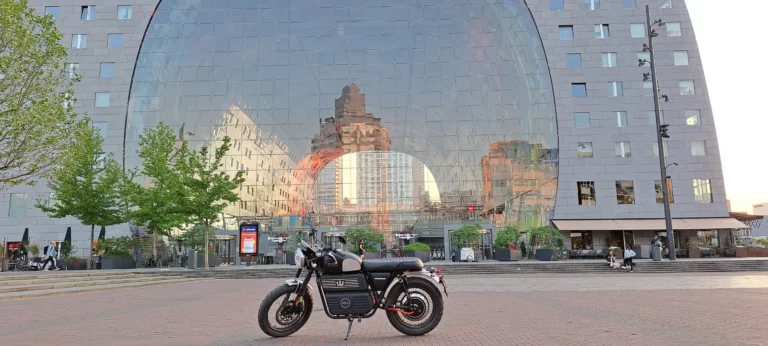
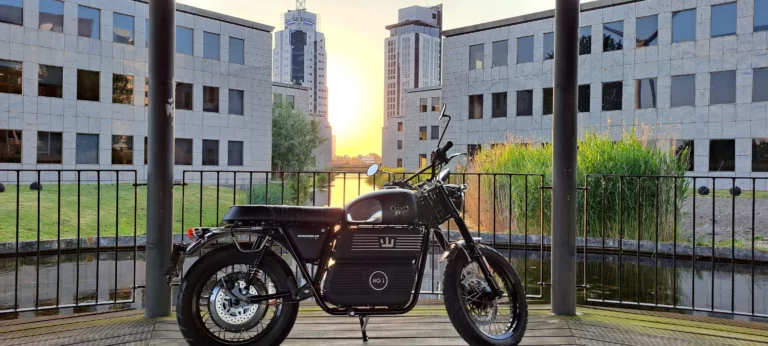
Riding modes and range: Realistic performance of the RGNT Scrambler
When picking up the bike, I inquired again about the range. It’s stated that a range of 150 km is mentioned, but this is obviously in the 9 kW mode, with active regenerative braking and gentle acceleration. Realistically, it’s around 100-120 km when driving in mixed commuting conditions. The RGNT Scrambler has 3 modes you can switch between and a fourth mode which the computer can activate. As a rider, you can choose from three modes: Normal; 9 kW, Dynamic; 13 kW, and Boost; 21 kW. Additionally, there’s a “turtle” mode where the motor is limited in acceleration and top speed. This is mainly for when the battery is almost empty, but I’ve also experienced it at an earlier moment.
As the modes become sportier, the range decreases, but the boost mode is only available for a limited time. This was deliberately done to not significantly affect the realistic range. The 100+ km mentioned is not only realistic, but personally, on multiple rides, I achieved closer to a 120 km range. This depends on how aggressive your riding style is and how much energy you manage to regenerate with active regenerative braking.
One caution I want to mention here. On the very hot day when I picked up the RGNT, I rode quite aggressively on my way home, to see what the RGNT can do. Boost whenever available, aggressive acceleration, and heavy regenerative braking, followed by full throttle acceleration. Surprisingly, this behavior had a minimal impact on the range. But with the full sun and warm weather, this did lead to a few moments where the RGNT switched to a lower mode because the motor or battery became too hot. You can keep riding without noticing much difference, and after a few moments, switch back to Dynamic. At the end of 2 to 3 hours of riding and ignoring this behavior a bit, the RGNT gave an overheating warning and activated “turtle” mode. The speed at which I was riding at that moment remained unchanged, only after stopping the speed limit was active. Honestly, this was also a good time for a drink break, and after 10 minutes of rest, I got back on and finished the rest of the ride. Without any further warnings or notifications.
The RGNT Scrambler is an A1 legal motorcycle because it’s determined differently for electric motorcycles than for gasoline engines. A gasoline engine for A1 may have a peak power of 11 kW. This is determined by the dynamic power of 11 kW for electric motors. So you can ride the RGNT on your A1 license, and with the boost mode, you can experience 21 kW, almost equivalent to 250cc.
In daily use, few people will drive the RGNT only in Normal mode, but mainly in Dynamic. Especially at traffic lights, Dynamic rides much smoother. For me, the RGNT in Dynamic mode gave a range of around 100 to 120 km under normal use. In winter, this may be slightly lower, despite the fact that the RGNT set the Speed World Record on ice with an electric motorcycle equipped with a modified Aurora. Not bad, and that promises something for the future of RGNT. Definitely a possible third version, the Aurora.
Charging the RGNT
Charging is relatively simple: lift the tank cap, plug the charging cable into the motorcycle and the socket, and you’re done. Unfortunately, this wasn’t so easy for me, but with a bit of creativity, I managed it all. Thanks to the included bag, I could also take the charger to work to charge the RGNT there. This wasn’t necessary; commuting back and forth on one battery is easily achievable with its range. However, since I couldn’t fully charge the RGNT the evening before, the option was nice. The included bag is available as an accessory in two colors at Coning Motoren for €269.95.
On the last day, charging on location wasn’t possible, and I had to travel from IJsselstein to Utrecht with a fairly low battery percentage. With a slightly more economical driving style, easing off the throttle earlier and avoiding abrupt maneuvers, this turned out not to be a problem in hindsight.
Charging from 20% to 80% took just under 3 hours, which is nice. Charging from 10% to 100% took just under 5 hours. According to RGNT, it’s possible to charge from 0% to 100% in 5 ½ hours, so that’s quite accurate.
It’s worth mentioning that, like most motorcycles, the RGNT doesn’t have a removable battery, something you do see with many electric scooters, such as the Brekr and the SuperSoco.
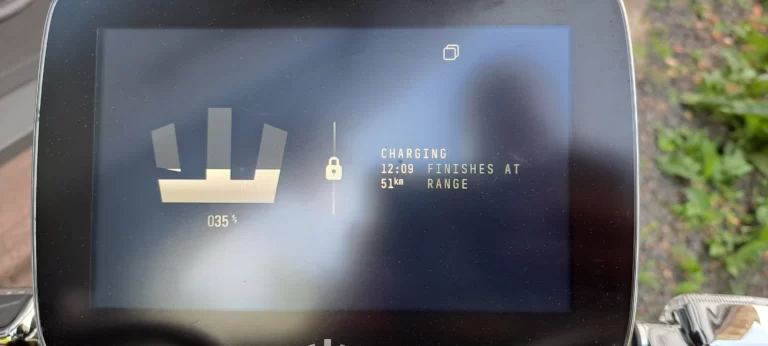
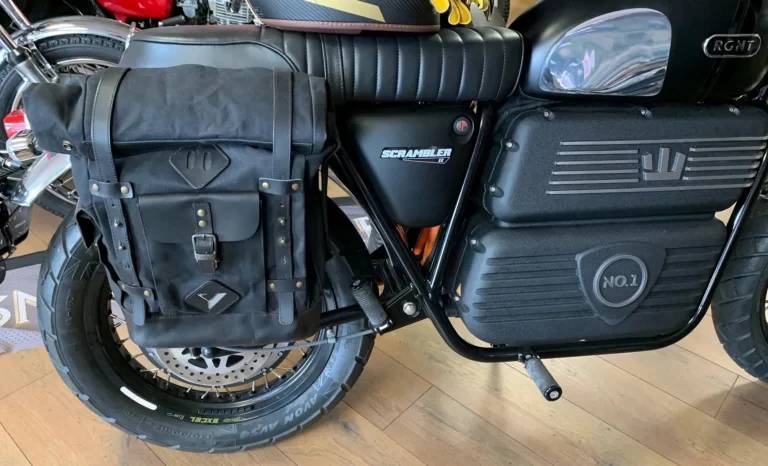
Optimal driving pleasure with perfect balance and full power
The RGNT scrambler comes with nicely sized wheels, especially considering the size of the motorcycle. A 110/80R18 tire is chosen for the front wheel, and a 130/80R17 for the rear. It’s a bonus that the RGNT Scrambler comes standard with Avon Trailrider tires. These are the same tires that were on my own motorcycle during testing, which immediately gave me more confidence to test the RGNT Scrambler.
Due to the battery and computer setup within the frame block, the RGNT has a nice low and central weight distribution, which aids in handling and cornering behavior. Because the motor is in the rear wheel, there’s no power loss due to friction or drag. In theory, power transfer is also more acute, although these differences are so small that you hardly notice them.
Thanks to the electric motor, the full power is always available, eliminating the hassle of searching for the right gear in the middle of a corner or encountering a false neutral when starting from a stoplight. However, you do notice that power builds up gradually when starting from a standstill, and unfortunately, you don’t get the full 100% from the first moment. It’s not LiveWire or Zero-level acceleration, but it does help with the extended range. The transition from throttle to hub motor feels very smooth and easily controllable. This provides excellent control over constant speed and acceleration.
From the dashboard, you have access to various settings, details about the motor’s performance, battery level, and much more. Over-the-air (OTA) updates and cloud connectivity are used to update RGNT motorcycles when necessary. Navigation is possible on the RGNT, but during testing of the Scrambler, it was still in the testing phase. The plan is to roll this out to all existing and new RGNT motorcycles free of charge in the third quarter of 2023. Navigation on the dashboard is a nice addition to the RGNT and helps bridge the somewhat higher price compared to other A1 electric competitors.
The control buttons on the handlebar are all easily accessible and operate smoothly. There’s a lot of “old-fashioned” mechanical features, which may not be to everyone’s liking, but personally, I had little problem with it. The turn signal button took some getting used to, but I quickly adapted. It would have been a nice addition if the turn signals automatically turned off after a turn, but that may be asking too much from a relatively young company. The same goes for cruise control. I didn’t miss it at all, but I can see the benefit for highway and somewhat boring 80 N-roads. This would also set the RGNT Scrambler apart from the competition. Everything is already electric on the RGNT, so it seems feasible to add it.
RGNT; Price overview and competition in the electric market
At the time of writing, the prices of the RGNT Classic and Scrambler range between $12,495 or £12,990, and $13,495 or £13,990. The price difference within the range depends on the Classic versus the Scrambler, the color of the motorcycle, and the seat. The FXE costs $12,495 or £12,500 at the time of writing, which falls within a similar price range, although it offers slightly less range. The cheaper electric motorcycles, such as the Horwin CR6, the Echopper M1p, the E-Odin, or even the TCMax from SuperSoco are all limited in their top speed. This ranges between 85 km/h and 95 km/h, but none of them are truly safe for highway traffic. The more expensive motorcycles like LiveWire, Zero, and Energica are in a higher class and have prices above €20,000. (Zero does have 2 “entry-level models” below 20k.)


Powerful brakes and comfortable saddle make the RGNT Scrambler a versatile choice
Euro 4 regulations (and subsequent Euro regulations) stipulate that a motorcycle up to 125 cc must have either ABS or combined brakes. ABS may not be ideal for off-road riding, which is a possibility for a Scrambler. You can choose to make the ABS switchable, simply on and off or with different modes. Or as RGNT has chosen, the second option; a combined braking system.
The right brake lever mainly brakes the front wheel. It comes on a bit softer, but is still quite powerful. Until you try the left brake lever. This brakes both front and rear and is very powerful. Combined with active rain and you practically come off your seat as a rider. Without ABS, you can of course have a locking brake, and especially the powerful left brake lever can lock your rear wheel. Nothing wrong with that, sometimes quite nice, but good to know.
Speaking of the seat, the Scrambler I had came with the black café racer/scrambler seat. The seat is nicely thin, which helps with holding onto the bike with your knees. And quite comfortable, once you’ve found your spot. You’re not sitting on the seat for more than 3 hours anyway, considering the range. But sitting on the seat for 3 hours also didn’t feel uncomfortable. The profile of the seat helps with grip, which is quite nice for more sporty cornering. Your seating position is fairly upright and relaxed. The RGNT itself isn’t very tall, but with this seating position, it feels like you’re sitting high. Standing is also very manageable, thanks to the thinner seat.
Off-road riding is therefore an option, it is after all a scrambler. Unfortunately, off-road, especially on trails filled with potholes and bumps, you notice that the RGNT carries quite a bit of weight. At 163 kg, that’s not too bad, and the RGNT Scrambler leans more towards the lighter side. It’s noticeable that the suspension isn’t tuned for off-road riding, or comes close to it. Standing is fortunately fine, and it absorbs a lot of bouncing. But whether all of that is good for the electronics? I think an RGNT rider who wants to go off-road more often would do well to look into other options for front and rear suspension.

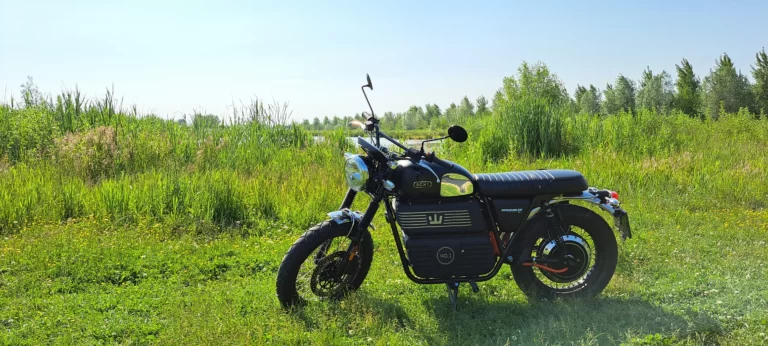
Conclusion
RGNT has introduced an A1-legal electric motorcycle to the market with their Classic and Scrambler models, catering to various niches. It appeals to the environmentally conscious A1 rider who not only seeks electric power but also desires highway capability. Alternatively, it appeals to those who appreciate the classic look of a motorcycle and prefer leisurely rides through nature, enjoying the sounds of birdsong. In some other European countries, individuals who have been driving cars legally for several years can also legally ride A1 motorcycles. In such cases, the RGNT provides a complementary option with its classic aesthetics.
What RGNT delivers feels complete both in terms of construction and performance. The future addition of navigation would be the cherry on top. It’s reassuring to know that all software updates, including navigation updates, will be provided free of charge, as RGNT currently has no interest in subscription models, which are becoming increasingly common. The combined braking system is smooth and highly effective. A version of cruise control would be a perfect addition for the future.
In reality, the 3 days with the RGNT Scrambler felt too short, and I wasn’t ready to return it. The use of the ‘One Throttle Drive’ and maneuverability in corners were impressive. I’ve been riding with a smile since day one. The newly announced cafe racer, resembling the world record holder “Aurora,” will undoubtedly attract attention as well. I’m certainly looking forward to it.
For those interested in experiencing the RGNT firsthand, the Netherlands will be the first to launch the Rent-a-RGNT option. This initiative stems from a collaboration between Coning Motoren (RGNT dealer in Utrecht) and Rusty Gold MotorShop in Amsterdam. It offers the opportunity to ride through Amsterdam or the surrounding green areas with friends. For more information, visit RGNT Motorcycles electrical rentals.
Type of engine | Hub motor, optimized for the RGNT |
Maximum Power | Nominal power 9KW – 13KW |
Range | 100-150 km (realistically around 120km) |
Battery | 1 Li-Ion |
Capacity | 9,5 kWh |
Charging time | 4 – 6 hours |
Max motor Torque | 390 Nm |
Frame | Swedish quality Steel Frame |
Front suspension | Ceriani replica of Paioli, with 120mm travel |
Rear suspension | 340 mm eye to eye, coil spring, spring preload adjustable |
Suspension travel | 120mm |
Front brakes | 300 mm diameter floating Disc, 4.5mm stainless steel |
Rear brake | 220 mm diameter Disc, 4,0mm stainless steel |
Brakes | J.Juan CBS Brake System (Combined Brake System) |
Wheels | Aluminum, spoked. |
Front tire | 110/80R18 – Standard with Avon Trialrider |
Rear tire | 130/80R17 – Standard with Avon Trialrider |
Length | 2110 mm |
Width | 840 mm |
Height | 1080 mm |
Wheelbase | 1410 mm |
Seat height | 810 mm |
Weight | 163,3 kg |
Weight battery | 60 kg |
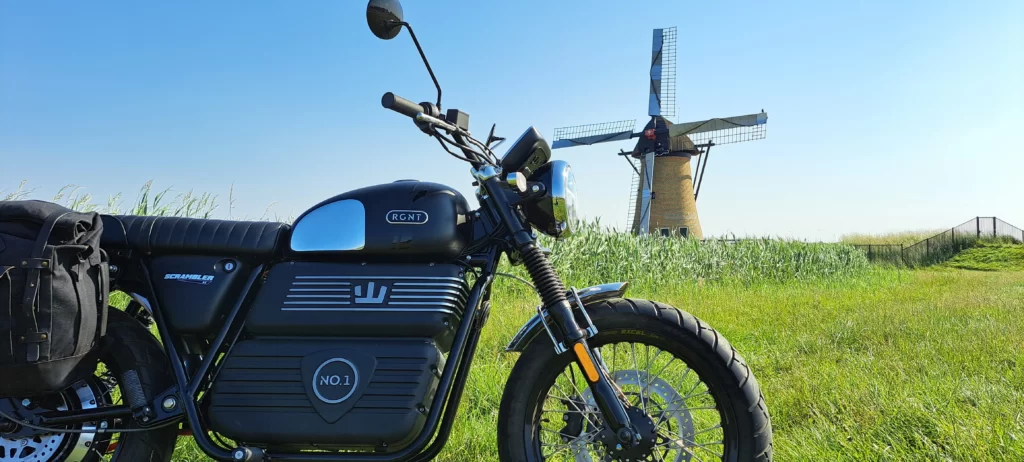
Meer Posts
Yamaha Neos Dual Battery – weektest (2024)
Brekr Model B – 2022 (Weektest)
Super Soco TS – 2021 (Weektest)